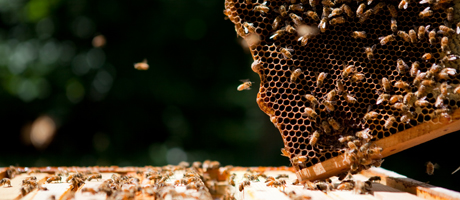By Magdalena Stuehrmann, Class of 2015
George Washington University is quickly becoming a haven for native flora and fauna.
Last week, the GW Grounds Team released over 12,000 ladybugs and 400 praying mantises on GW’s Foggy Bottom Campus to control mosquitoes and other pests.
And on Friday, the Grounds Team will be assisting GW senior Heidi Wolff in a pollinator-planting project in honor of Earth Day. GW students are invited to volunteer from 11 a.m. to 3 p.m. Friday by helping to replace existing plants with native flowering plants to bolster pollinators.
“Native pollinators tend to do better with plants they’re used to rather than genetically modified landscaping plants,” said Ms. Wolff, a biology major in the Columbian College of Arts and Sciences, who created Urban Green Bee, a research project focused on pollen quality and content. Ms. Wolff is particularly interested in the impact pollen has on bees’ health in urban environments compared with those in rural areas.
Both of these projects reflect this year’s theme for GW’s Earth Month celebration: “Get to Know Your Ecosystem.” As part of its Earth Day festivities, the GW Office of Sustainability will host an Earth Day fair from 10 a.m. to 2 p.m. tomorrow on Kogan Plaza with remarks from GW President Steven Knapp at 10 a.m. Students, faculty and staff can then join Ms. Wolff and the GW Grounds Team on G Street between 20th and 21st streets as they restore native plants to the GW ecosystem and provide nests and host plants for native pollinators such as solitary native bees and butterflies.
Many of the plants found in urban landscapes are bred for their color and decorative qualities and are not native to the region. Because of this, they have lower pollen and nectar levels than are ideal for pollinators, said Ms. Wolff. Native plants, however, have not been bred to reduce their pollen and nectar yields, making them far more valuable to pollinators.
“GW’s campus used to be swampland, so the ecosystem has already been distributed in some way. But the more we can reintroduce native plants and pollinators, the more we can help to enhance and nourish our D.C. ecosystem,” said Sophie Waskow, sustainability project facilitator in the Office of Sustainability.
In addition to adding pollinator-friendly plants that provide food and shelter, the Urban Green Bee team will place nests of various types for native bees near the pollinator gardens.
“We’ll be working with the Grounds Team to create native pollinator gardens, not only for bees but for butterflies and hummingbirds and other native pollinators too. We’ll be planting host plants for the butterfly larvae to develop on and plants that are attractive to various pollinators,” said Ms. Wolff.
Ms. Wolff uses her research on pollen quality, biodiversity, pesticides and bees’ health for education and ecosystem enhancement. She works with local youth, coming to classes and giving presentations on the environment, bees and pollination. Ms. Wolff sees tomorrow’s project as another opportunity to not only help native pollinators but also to educate people about their value to the local ecosystem.
“We’re putting the gardens in a great area, because lots of people walk past there every day, even people who aren’t in the GW community,” said Ms. Wolff.
Ms. Waskow said GW can be a model for urban sustainability through its efforts to enhance its ecosystem with pollinator-friendly plants and through tactics such as releasing ladybugs and praying mantis on campus.
These native predators, who feed on insects like mosquitoes and aphids, can reduce the number of pesky insects without resorting to pesticides, said Noel Gasparin, a contractor with the Grounds Team who has worked with plants his entire career and specializes in pest management.
“This technique helps to restore the natural balance of biodiversity on our campus without introducing harmful unnatural chemicals,” said Ms. Waskow.
As part of the Earth Day fair, GW plans to announce its Ecosystem Enhancement plan. According to Ms. Waskow, the plan, which will focus on improving the ecosystem on its campuses as well as the greater D.C. area, will fit in with the university’s existing water and climate change initiatives.
“The work that is going on here is very innovative,” said Ms. Waskow. “Often, people don’t think of cities as being sustainable, but it’s important for students and the community to realize that urban settings can be beacons for sustainable living. GW is committed to enhancing the urban ecosystem and to engaging our entire community in helping to realize our vision for a future with resource systems that are healthy and thriving for all.”


